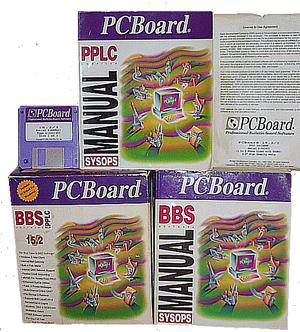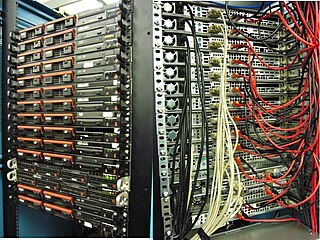
A bulletin board system (BBS), also called a computer bulletin board service (CBBS), is a computer server running software that allows users to connect to the system using a terminal program. Once logged in, the user can perform functions such as uploading and downloading software and data, reading news and bulletins, and exchanging messages with other users through public message boards and sometimes via direct chatting. In the early 1980s, message networks such as FidoNet were developed to provide services such as NetMail, which is similar to internet-based email.
FidoNet is a worldwide computer network that is used for communication between bulletin board systems (BBSes). It uses a store-and-forward system to exchange private (email) and public (forum) messages between the BBSes in the network, as well as other files and protocols in some cases.

An Internet café, also known as a cybercafé, is a café that provides the use of computers with high bandwidth Internet access on the payment of a fee. Usage is generally charged by the minute or part of hour. An Internet cafe will generally also offer refreshments or other services such as phone repair. Internet cafes are often hosted within a shop or other establishment. They are located worldwide, and many people use them when traveling to access webmail and instant messaging services to keep in touch with family and friends. Apart from travelers, in many developing countries Internet cafés are the primary form of Internet access for citizens as a shared-access model is more affordable than personal ownership of equipment and/or software. Internet cafés are a natural evolution of the traditional café. As Internet access rose many pubs, bars and cafés added terminals eroding the distinction between the Internet café and normal cafés.
An online service provider (OSP) can, for example, be an Internet service provider, an email provider, a news provider (press), an entertainment provider, a search engine, an e-commerce site, an online banking site, a health site, an official government site, social media, a wiki, or a Usenet newsgroup.

Ward Christensen is the co-founder of the CBBS bulletin board, the first bulletin board system (BBS) ever brought online. Christensen, along with partner Randy Suess, members of the Chicago Area Computer Hobbyists' Exchange (CACHE), started development during a blizzard in Chicago, Illinois, and officially established CBBS four weeks later, on February 16, 1978. CACHE members frequently shared programs and had long been discussing some form of file transfer, and the two used the downtime during the blizzard to implement it.

Irish coffee is a caffeinated alcoholic drink consisting of Irish whiskey, hot coffee and sugar, which has been stirred and topped with cream. The coffee is drunk through the cream.

Thomas Daniel Jennings is a Los Angeles-based artist, known for his work on FidoNet and for his work at Phoenix Software on MS-DOS integration and interoperability.
The Bread Board System (TBBS) is a multiline MS-DOS based commercial bulletin board system software package written in 1983 by Philip L. Becker. He originally created the software as the result of a poker game with friends that were praising the BBS software created by Ward Christensen. Becker said he could do better and founded eSoft, Inc. in 1984 based on the strength of TBBS sales.
WWIV was a popular brand of bulletin board system software from the late 1980s through the mid-1990s. The modifiable source code allowed a sysop to customize the main BBS program for their particular needs and aesthetics. WWIV also allowed tens of thousands of BBSes to link together, forming a worldwide proprietary computer network, the WWIVnet, similar to FidoNet.

PCBoard (PCB) was a bulletin board system (BBS) application first introduced for DOS in 1983 by Clark Development Company. Clark Development was founded by Fred Clark. PCBoard was one of the first commercial BBS packages for DOS systems, and was considered one of the "high end" packages during the rapid expansion of BBS systems in the early 1990s. Like many BBS companies, the rise of the Internet starting around 1994 led to serious downturns in fortunes, and Clark Development went bankrupt in 1997. Most PCB sales were of two-line licenses; additional line licenses were also available.
Nando was an American internet news service and Internet service provider (ISP), founded in 1993 by the publishers of The News & Observer newspaper in Raleigh, North Carolina. Initially it relied on access via bulletin board technology. One of the first 24-hour news websites, the Nando Times, was launched in 1994, providing edited information from major news agencies that had not then developed their own websites.

The Major BBS was bulletin board software developed between 1986 and 1999 by Galacticomm. In 1995 it was renamed Worldgroup Server and bundled with a user client interface program named Worldgroup Manager for Microsoft Windows. Originally DOS-based, two of the versions were also available as a Unix-based edition, and the last versions were also available for Windows NT-based servers.

Community Memory (CM) was the first public computerized bulletin board system. Established in 1973 in Berkeley, California, it used an SDS 940 timesharing system in San Francisco connected via a 110 baud link to a teleprinter at a record store in Berkeley to let users enter and retrieve messages. Individuals could place messages in the computer and then look through the memory for a specific notice.
Pagan's Night Out, or PNO, is a regularly scheduled social get-together, usually monthly, held in hundreds of Pagan and Neopagan communities around the world. It began in Houston, Texas, in 1992 as a way for users of the Brewers' Witch BBS to meet face to face, Pagan's Night Out has become a worldwide phenomena. Held in bars, pubs, coffee shops, cafes, restaurants and meeting halls, PNO is a social event for Wiccans, Asatruar, Thelemites, Druids, Setians and the hundreds of other Neopagan sects and sub-divisions.

The Berkeley Macintosh Users Group, or more commonly "BMUG", was the largest Macintosh User Group. It was founded in September 1984 by a group of UC Berkeley students including Reese Jones and Raines Cohen as a focal-point for the nascent Apple Macintosh user community. With more than 13,000 members, or "BMUGgers" at its peak in 1993, the group was the largest, and generally understood to be the most important, Macintosh users group. A few of the notable members include John "Captain Crunch" Draper, the Sultan of Brunei Hassanal Bolkiah, notorious murderer Enrique Zambrano, early hacker-chaser Cliff Stoll, Inktomi founder Eric Brewer, and may prominent computing journalists like John Dvorak, Ilene Hoffman, Leo Laporte and Adam Engst. An example of the group's omnipresent blue-floppy-disk lapel pin is held in the Smithsonian Institution's American History collection. BMUG's history and activities were closely linked with the MacWorld Expo meetings, traditionally held in San Francisco each January and Boston each August.

The Thing is an international net-community of artists and art-related projects that was started in 1991 by Wolfgang Staehle. The Thing was launched as a mailbox system accessible over the telephone network in New York feeding a Bulletin Board System (BBS) in 1991 before their website was launched in 1995 on the World Wide Web. By the late 1990s, The Thing grew into a diverse online community made up of dozens of members' Web sites, mailing lists, a successful Web hosting service, a community studio in Chelsea (NYC), and the first website devoted to Net Art: bbs.thing.net.

Blue Bottle Coffee, Inc., is a coffee roaster and retailer once headquartered in Oakland, California, United States. In 2017, a majority stake in the company was acquired by Nestlé (68%). It is considered a major player in third wave coffee. The company focuses on single-origin beans.

Super Dimension Fortress is a non-profit public access UNIX shell provider on the Internet. It has been in continual operation since 1987 as a non-profit social club. The name is derived from the Japanese anime series Super Dimension Fortress Macross; the original SDF server was a Bulletin board system created by Ted Uhlemann for fellow Japanese anime fans. From its BBS roots, which have been well documented as part of the BBS: The Documentary project, SDF has grown into a feature-rich provider serving members around the world.

Toasternets were an early-1990s instantiation of the decentralized Internet, featuring open-standards-based federated services, radical decentralization, ad-hoc routing and consisting of many small individual and collective networks rather than a cartel of large commercial Internet Service Provider networks. Today's "community networks" and decentralized social networks are the closest modern inheritors of the ethos of the 1991-1994 era Toasternets.













